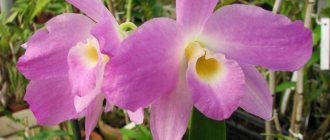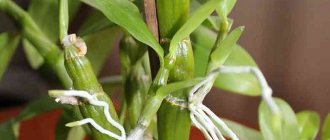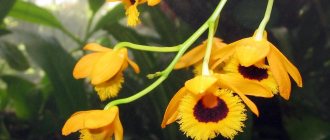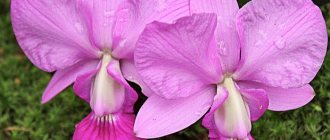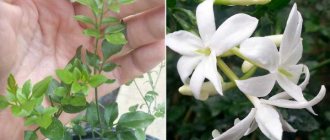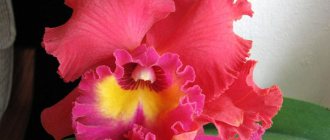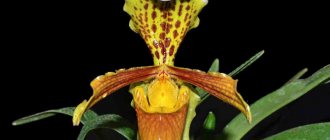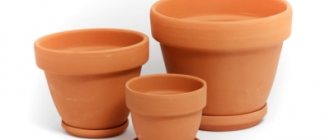Dendrobium is an unpretentious, beautifully flowering orchid. An epiphytic species with lanceolate leaves and large, showy flowers of a wide variety of colors.
Despite the wide variety of species, they all have one thing in common - the tube-shaped base of the flowers. Depending on the type, the height of the plant can vary from 20-30 cm to 1 meter. The dendrobium orchid is native to the tropical rainforests of Thailand, Malaysia and Sri Lanka.
Also see how to grow orchids such as vanda and paphiopedilum.
| The growth rate is high. Every year a new pseudobulb grows up to 70 cm. |
| Blooms in summer with proper care. |
| The plant is easy to grow. One of the easiest orchids to grow. |
| It is a perennial plant. |
Dendrobium: care at home. Briefly
Dendrobium orchid at home requires strict adherence to the rules of care:
| Temperature | In summer 15-30°, in winter 15-20°. |
| Air humidity | The creation of special conditions does not require. |
| Lighting | Requires a lot of bright, sunlight. |
| Watering | A special, loose substrate for orchids based on bark. |
| Soil for dendrobium orchids | Light, permeable and nutritious soil. |
| Feeding and fertilizer | During the period of intensive growth, use special fertilizers for orchids. |
| Orchid transplant | As it grows, in the spring. |
| Dendrobium propagation | Dividing overgrown plants. Cuttings and children. |
| Features of growing orchids | To set flower buds, a difference between day and night temperatures is required. |
Mistakes when caring for the dendrobium nobile orchid and their elimination
Inexperienced gardeners sometimes make a number of mistakes that lead to illness or even death of the orchid:
- Place the plant in direct sunlight immediately after spraying. As a result, burns form on the leaves.
- Spray foliage at room temperatures below +20 °C. This leads to the appearance of rot.
- After spraying, do not remove excess water from the leaf axils. They begin to rot at the base.
- Do not provide enough light. An orchid does not bloom in such conditions.
- Do not reduce the temperature and frequency of watering during the dormant period. Flowering does not occur.
Caring for dendrobium at home. Details
Caring for a dendrobium orchid at home cannot be called difficult, but it still has a number of features.
Dendrobium orchid blooming
Dendrobium blooms after a short period of dormancy. Peduncles appear only on 2-3 year old bulbs. The total duration of the flowering period is 2-3 weeks.
The number of flowers directly depends on the temperature and light intensity during the dormant period. After flowering, old bulbs are not cut off. They should dry naturally. In this case, the nutrients accumulated in them will be absorbed by the remaining shoots.
New varieties of dendrobiums can bloom without a dormant period. The process of ripening and formation of bulbs continues in winter. The main thing is to provide the plant with the necessary lighting.
Temperature
The homemade dendrobium orchid develops well at normal room temperature. At the same time, it is desirable for her to ensure a difference between day and night temperatures. Lower temperatures at night promote the ripening of shoots and the formation of flower buds.
Spraying
All modern varieties of dendrobiums are perfectly adapted to the usual level of humidity in residential premises. Therefore, as a rule, they do not require spraying.
Lighting
The dendrobium orchid plant at home requires intense lighting. Varieties with dark-colored flowers are especially demanding in terms of light levels. In autumn and winter, southern windows are best suited for dendrobium.
In the summer, the plant must be moved to the east or west side.
Watering dendrobium orchids
Watering of dendrobium is carried out using the immersion method.
To do this, place the pot in a cup of warm water for 15-20 minutes. Irrigation water must be settled or filtered before use. Once a month, watering is replaced with a warm shower. The frequency of watering depends on the ambient temperature. In summer the plant is watered much more often, in winter very rarely. If the orchid is kept in the cold, watering is stopped completely. In case of severe wrinkling of the bulbs, simply spray it with warm water. In general, the substrate in the pot should dry completely between waterings.
Dendrobium orchid pot
For young orchids, choose small transparent pots made of plastic. To prevent the plants from turning over, several stones are placed on the bottom. Heavy, ceramic flowerpots are suitable for planting large, heavily grown specimens.
Priming
Dendrobium orchid is grown at home on a substrate of bark and moss. The soil mixture is prepared at the rate of 1 part crushed moss to 1 part bark, plus a small amount of pieces of charcoal and peat. Before planting, the substrate must be spilled with boiling water.
Feeding and fertilizer
To feed dendrobium, use special fertilizers for orchids. They are applied in the form of solutions every 3 or 4 waterings. If necessary, foliar sprays can also be used. During the dormant period, fertilizers are not used.
Transplanting a dendrobium orchid
Dendrobium orchid transplantation is carried out after the flower stalks dry out at the moment when the plant begins to grow intensively.
The need for transplantation is determined by the condition of the substrate. If it has decomposed, become salty, or mold has appeared on its surface, the plant must be replanted. During transplantation, pay attention to the condition of the root system. All rotten and blackened areas of roots must be cut back to healthy tissue. The resulting cut areas must be sprinkled with charcoal powder or cinnamon. In some cases, the plant may even need a smaller pot after root treatment.
After transplantation, the plant is not watered for a week.
Trimming
Dendrobium does not need special pruning. If necessary, completely dried stems and leaves are removed from the plant.
Rest period
For the mass formation of flower buds, the plant needs a period of rest. To do this, after growth has finished, the dendrobium is transferred to dry conditions at night temperatures no higher than +15-18°. In this case, the plant must be well lit. In such conditions, the flower is kept for at least 1.5 months.
During this period, the dendrobium is not watered. To prevent the bulbs from wrinkling, the shoots are sprayed with cool, pre-settled water 1-2 times a week.
Features of flowering bush plants
Often, Dendrobium that blooms profusely after purchase refuses to form buds again. The reason for this phenomenon is non-compliance with care recommendations and plant maintenance conditions.
The orchid does not bloom for the following reasons:
- Violation of watering standards. Inexperienced gardeners try to moisten the substrate as often as possible, believing that this makes the plant feel better. As a result, the flower, overflowing with juice, actively releases it into the dry air of the room, and the peduncle remains without water. Insufficient watering is also harmful because it causes the pseudobulbs to shrink and new shoots to not form.
- Lack of intense lighting. Lack of light directly affects the process of bud formation.
- Limited temperature differences between day and night. To stimulate flowering, Dendrobium requires a difference of 3-5 degrees, which brings the plant closer to natural conditions. At night, the pot is taken out to the balcony or placed indoors with the window slightly open.
- Lack of fertilizing or excessive nitrogen content.
How to make it bloom?
An important point in stimulating the flowering of Dendrobium is maintaining the life cycle established at the genetic level. Natural need of the plant:
- coolness in autumn and winter;
- warm - in spring and summer;
- maximum intense lighting all year round.
Important! The microclimate of apartments is stable throughout the year, and as a result, the natural change of seasons is lost. Under such conditions, Dendrobium begins to degenerate and stops forming buds. Over time, the plant may not only stop blooming, but also die.
Dendrobium enters the flowering phase in winter. Then it begins a period of active vegetative growth, when new shoots appear from the lower part. Their complete formation occurs during spring and summer. Autumn is a time of rest and the beginning of bud formation.
For this process to proceed correctly, the following conditions must be created:
- In summer, the flower is placed in an open space (balcony, veranda, courtyard, open window) at a temperature of at least 10 degrees. But if you have just purchased Dendrobium, you cannot immediately put it outside after keeping it in the store in a greenhouse.
- Intensive watering during growth in spring and summer.
- Stop moistening after shoot growth stops. It is resumed when flower buds appear on the shoots. If you do this earlier, new shoots will begin to grow, but buds will not form.
- The air temperature during the period of vegetative activity is maintained at 20-25 degrees. At night it is reduced by 5 degrees. These fluctuations, combined with a lack of watering and intense light, promote flower formation.
How to care during flowering?
The flowering time of Dendrobium is 8-12 weeks. From the moment of coloring and the beginning of the opening of the first buds, active watering begins. It is important to maintain a high level of humidity during flowering. If this is not done, the plant will perceive the dry air as a signal to end flowering.
Attention! During flowering, you should not touch the pot too often or turn the plant. Otherwise, Dendrobium will begin to drop its buds.
What to do next when it has finished blooming?
At the end of flowering and drying, the arrows are cut off. Dendrobium begins a dormant period, so it is installed in a cool room (16-17 degrees). Watering is reduced during rest periods. But illumination must be maintained at a high level at all times. If daylight hours are short, Dendrobium is additionally illuminated with fluorescent or phytolamps.
Propagation of dendrobium orchid by dividing the bush
When transplanted, strongly overgrown dendrobium specimens can be divided into several parts. Each of them must have at least 3 well-developed, healthy bulbs. In some cases, it is allowed to leave a smaller number of shoots. But such plants, as a rule, take much longer to take root.
The sections formed after division must be dried and treated with charcoal powder or a weak solution of brilliant green. The cuttings are planted in a substrate for adult plants. During the first week they are only sprayed. In the future, they are watered little by little and very carefully. The usual watering regime is resumed only when the plants begin to grow.
After 2-3 weeks from planting, they can be fed with special fertilizer for orchids.
Which pot to move the plant into?
Dendrobium nobile is a rather large plant, especially adult specimens. Therefore, it is better to choose an air-permeable clay container with good drainage holes.
Before planting, the clay container needs to be prepared: calcined in the oven, allowed to cool and soaked in clean, settled water for 2 hours.
There are now a lot of special ceramic orchid pots on sale that have holes on the walls, which significantly improves gas exchange in the root system. The size of the pot should correspond to the size of the root system and only 2 cm exceed the diameter of the previous one. Recently, many decorative pots have appeared that are suitable for growing orchids
Propagation of dendrobium orchid by cuttings
At home, cuttings can be used for propagation. They are cut from shoots that have ripened but have never bloomed. Faded pseudobulbs with dormant buds remaining on them are also suitable for propagation. If the shoot is too long, it is cut into several parts about 10 cm long. All resulting sections must be processed. If the shoot is short, it is used entirely.
For rooting, prepare bags with wet moss. Prepared cuttings are placed in them. After this, the packages are hung in a well-lit, warm place. After a few weeks, babies begin to develop on the pseudobulbs. As soon as the young plants form root primordia, they are carefully separated.
For planting children, small greenhouses with substrate for adult plants are used. High humidity promotes accelerated root development. The disadvantage of this method of propagation is that plants obtained in this way will bloom no earlier than after 3-4 years.
Reproduction and transplantation
Transfer
The dendrobium orchid should not be replanted very often; once every three years is enough. This plant is replanted in the spring months, after flowering. An orchid also requires replanting when its roots have little space or become sick.
As a filler for an orchid, a special substrate is suitable, which contains: bark, moss (for moisture) and foam balls (so that the soil does not cake). When replanting, you should handle the roots carefully.
For this flower, ordinary flower pots (opaque) are selected, and drainage is placed at the bottom before planting. The plant should be watered a week after planting.
Bloom
This stage is typical for orchids from January to April. Before flowering, the plant goes through a full cycle, from active growth to dormancy. Dendrobium blooms for up to two months.
Before the plant is about to throw out its flowers, it should be watered less often and placed in a place where there is a lot of light. As a rule, after flowering, the leaves of the plant turn yellow, thus preparing for a new cycle.
Reproduction
- Dividing the bush is so that each young plant has three adult pseudobulbs and roots.
- Division by “children” is a method of reproduction by shoots grown on the stem of an adult orchid. The babies are ready for propagation when they reach 5 cm in length and their roots are 3 cm long. They are carefully cut with a knife and planted in a separate pot. In order not to injure the roots of young plants, the substrate is soaked in water for 24 hours, and the roots of the children themselves are kept in warm water for 10 minutes before planting.
Reproduction of dendrobium orchids by children
Babies are periodically formed on the pseudobulbs of dendrobium. They can be used for reproduction. The children are separated after the rudiments of roots develop on them. On average, this takes about a year. Using a sharp knife, they are cut off with a small piece of the mother stem or separated with a twisting motion. The resulting sections must be dried for several hours and then treated with a solution of brilliant green.
Children with well-developed roots are planted in small pots with a regular substrate for dendrobiums. The first few days they are not watered, but only sprayed. In the future, they do not need to create any special conditions; ordinary care is quite enough. Such plants, if grown correctly, can bloom as early as next year.
Preparing for flowering
Dendrobium nobile blooms at different times of the year, this is due to the incredible number of hybrid forms. The flowering period takes a month, sometimes a little more. Its duration directly depends on the air temperature of the room in which the plant is kept. The higher it is, the sooner the orchids will bloom. The ideal temperature for flowering is 18 C.
Sometimes an orchid refuses to bloom. Why? This happens if you do not pay attention to the plant’s requirements for living conditions. If you maintain the correct combination of lighting, temperature and watering parameters, then no problems with the development of flower buds will arise.
- Starting in spring, lighting should be as bright as possible.
- The temperature during the day is within 25 C and no higher, at night it is 3–5 C lower, otherwise the flower buds will degenerate into growth buds.
- Watering abundantly, with good drying of the substrate.
- Don't overdo it with fertilizers. Increased concentration can harm the roots.
After flowering, all flower stalks are removed. If there is a need for a transplant, do it. Do not water the orchid for several days after transplantation to prevent the possible development of rot on the roots.
And most importantly, after flowering, the orchid must undergo a period of rest.
Do not rush to remove old yellowed pseudobulbs. They will serve as food for young growing shoots. You can cut them only after they are dry. Don't forget to sprinkle the cut area with crushed coal.
For Dendrobium nobile to bloom actively, it needs a lot of light.
Diseases and pests
Due to errors in care, an orchid can suffer from a number of diseases:
- Dendrobium does not bloom. Lack of flowering is most often due to insufficient lighting or lack of a dormant period. To correct the situation, the plant must be moved to a brighter place and ensure the correct temperature conditions.
- The roots rot. Most often it is a consequence of excessive watering. The substrate should dry out between waterings.
- Dendrobium leaves have lost turgor and become lethargic. The plant most likely suffers from lack of moisture and high temperature. In hot weather, the orchid should be watered without waiting for the substrate to dry completely.
- Dendrobium leaves turn yellow. The reason may lie in an excess of fertilizers. When applying fertilizing, it is necessary to strictly follow the recommended norms.
- The leaves are pale and light. The plant lacks calcium and magnesium. To eliminate the deficiency, it is recommended to apply appropriate fertilizers.
- Brown spots on dendrobium leaves. The plant has suffered from direct sunlight or too high a temperature. The orchid should be moved to partial shade or shaded from the sun.
- The tips of dendrobium leaves dry out. Most often, this phenomenon occurs when the air is too dry or if the plant pot is located next to a heating radiator.
The most common pests that attack dendrobium are spider mites, whiteflies, aphids, and scale insects. To combat them, it is necessary to use special insecticides.
Mistakes in courtship
- If the dendrobium does not receive a sufficiently dry and cool period, the babies will grow not from the substrate, not from the roots, but on the plants themselves.
- When spraying this plant, be sure to prevent water from getting into the axils of the leaves. If water gets into the axils of the leaves, the trunk will begin to rot. It is advisable to place the pot with the plant in a container with wet peat, expanded clay or moss.
- Improper care can affect the health of the flower. If all requirements for ensuring comfortable conditions are met, the leaves of the plant will have a green color without changes in any direction:
When coloring the leaves in a bright light green color, it is necessary to provide the plant with a little shade, since the flower gets too much sun. - If the leaves of the dendrobium are dark green, this means that there is not enough light for the flower.
- When the leaves turn yellow, it is necessary to change the location of the plant, as this indicates that the flower does not have enough sun.
- With high humidity, dendrobium can become infected with fungus. This indicates that the soil is over-watered, which leads to rotting of the roots. This is a difficult case, because it is very difficult to help such a plant; only replanting it in new soil can revive it. A prerequisite is the removal of all rotten roots and their parts. Uninfected roots must be treated with charcoal and dried. After this procedure, watering the plant should begin only ten days from the date of transplantation.
- If the dendrobium does not bloom for a long time, it can be assumed that the reason for this may be excessive illumination during the dormant period of the flower, or watering during the formation of buds, so the flowers do not appear, but new children are formed. This is also due to insufficient illumination during the period of flower growth.
- Another problem is the pseudobulb turning brown or yellow.
The reason for this may be the beginning of the process of rotting of the plant as a result of improper watering. The solution to the problem is to remove the damaged parts or replant the dendrobium. Advice : Replanting a flower should only be done after first cleaning the plant from rotten roots. Yellow color is always a sign of disease. - Lower leaves may fall off. In this case, there is no need to worry, because this is a normal phenomenon after the flowering period of the plant.
- Sometimes you can notice that the plant’s stem has shriveled. This happens during the period of growth of new shoots. Young shoots need a large amount of nutrients, which they safely take from the plant itself, which leads to its slight drying. The shoots may look excessively thin, but new shoots gradually gain the required thickness. After growth has finished, they will have a standard appearance.
Types of orchid dendrobium domestica with photos and names
In indoor floriculture, the following types are most widespread:
Dendrobium nobile
Large epiphytic species. It is characterized by dense, articulated stems with constrictions in the area of internodes up to 70 cm high. The leaf blades are arranged in two rows. The total lifespan of the stems does not exceed 2 years. Peduncles are short, appearing on last year's shoots. Consist of 2-4 brightly colored flowers with a characteristic turned-down lip.
Dendrobium phalaenopsis
A large species with lanceolate leaves located at the top of the fleshy shoots. The peduncle is curved, up to 60 cm long. The flowers are collected in large, drooping racemes. Their color varies from soft pink to deep crimson. In this case, the lip is always colored more intensely. With good care, the flowering period can last up to six months. The species is grown as an industrial crop to obtain high-quality cuttings.
Dendrobium densiflorum
A species with tetrahedral stems covered with membranous sheaths. The top of the shoots is crowned with 3-4 lanceolate leaves. The inflorescences consist of many flowers collected in large drooping racemes. The length of the brushes can reach up to 30 cm with the number of colors exceeding 50 pieces. The flowers are about 5 cm in diameter, bright yellow in color with an orange stripe along the edge of the lip.
Dendrobium hybrids bred on the basis of the species described above are also widespread in indoor culture:
Dendrobium Stardust
Prized for its original red-orange color with brown streaks.
Dendrobium Dorrigo 'Wisteria'
It has interesting stems that resemble reeds.
Dendrobium Formidable
It was obtained by crossing D. formnsum and D. infundibulum.
Dendrobium Red Fair 'Akebono'
A brightly colored hybrid with a contrasting lip.
Reproduction
Dendrobium is a plant with sympodial growth that reproduces by pups, division, pseudobulbs and cuttings.
Children are daughter plants of an orchid; when propagating this kind of plant, the orchid bush is removed from the flowerpot along with all the pseudobulbs of the daughter plant. The rhizomes and bulbs must be separated, and the lower part of the dendrobium must be cut so that each child is left with at least one bulb and part of the main root. Subsequently, the children are seated in a pot with good drainage and periodically fed with fertilizers, and the growth of rhizomes is also stimulated with the help of hormonal agents.
When propagated by pseudobulbs, they are divided into parts so that each of them has rudimentary buds, while the pseudobulb should not be flowering.
Overgrown dendrobium orchid bushes reproduce by division. It is enough just to transplant part of the bush into another flowerpot. The dendrobium bush is divided after flowering. First, the flower is removed from the pot, and then the roots are carefully unraveled to avoid damage. If some part of the roots cannot be untangled, they are cut off and the cut area is sprinkled with crushed coal - this will help dry the damaged area and prevent infection.
Deciduous species of dendrobium are propagated by cuttings; cuttings 10 cm long are cut from pseudobulbs separated from the mother bush. To plant cuttings, you need to wait until the roots germinate; just place them in damp sphagnum moss. As soon as the first roots appear, the cuttings must be planted in separate pots, and the cutting areas must be pre-treated with crushed coal.
Rhynhostilis
Orchid Rhynhostilis belongs to the category of monopodial orchids . Habitats:
- Thailand;
- Burma;
- Vietnam;
- China.
The Rhynhostilis orchid grows in the shade of trees and shrubs.
Orchids cling to trees with their root system and grow in their shade, escaping from the scorching sun.
The orchid fell in love with the gardener for its incredible color : the petals are usually soft white with burgundy and purple splashes, and are about 3 centimeters in diameter. The peduncle is quite long, hanging, can reach about 45 centimeters, and about 50 flowers can grow on one peduncle.
A distinctive feature of the rhynchristilis orchid. The color is light cream, with pink veins. The lateral parts of the lip are small and raised upward.
Gigantea
This type of rhynchostilis has a rich and pleasant smell . As for care, the plant is very unpretentious and adapts to any conditions.
However, this variety also has its disadvantages: the orchid grows extremely slowly. Therefore, do not panic if the plant does not enjoy active growth and flowering for a long time; most likely, it is simply not mature enough.
Rhynhostilis Gigantea.
The leaves reach enormous sizes - approximately 40 cm in length and 7 cm in width. The flowering period generally lasts about two weeks and occurs in late autumn or early winter.
Dulled
This variety is medium in size, but the peduncle can reach about 55 centimeters in length, and the number of flowers can go well beyond a hundred. The flowers of obtuse rhynchostylis are small, barely reaching two centimeters in diameter.
The color of the petals is light pink with dark red veins and specks. The lip is also distinguished by burgundy shades .
Rhynchostylis blunted (Rhynchostylis retusa).
Rules of care
- Daytime temperature is 22-27 degrees, night temperature is about 18 degrees. As for any variety of orchid, rhynchostilis obtuse needs temperature changes, at least 5 degrees. If the temperature remains the same both day and night, the orchid is unlikely to bloom;
- Favorable humidity – at least 65%. If the indicators are significantly lower, you may not wait for flowering. To maintain the required level of moisture, you should spray the flower with a spray bottle or purchase a special device that humidifies the air;
- Ideal substrate there will be one that easily allows air to pass to the roots. For example, it could be a mixture of moss, charcoal and pine mountain. There is drainage at the bottom of the pot;
Rhynhostilis orchid does not need abundant watering. - The orchid does not need abundant watering . This also applies to the flowering period. Flower growers recommend periodically drying the roots. During the period of active growth, it is recommended to water the orchid once every two to three weeks. A fertilizer solution should be added to the irrigation water;
- The optimal period for receiving light during the day is 10 hours; in winter, fluorescent lamps are used;
- A distinctive feature of rhynchostylis is its year-round flowering. The busiest period occurs in July-August.
Tips for caring for the Rhynhostilis orchid:
- Rhynhostilis takes a long time to adapt to changes in environmental conditions, so moving the plant is not recommended;
- The flower should be replanted no more than once every two to three years;
- After abundant watering, make sure that no moisture remains on the leaves.
Find out in the video how to properly care for the Rhynhostilis orchid:
Aftercare
After transplanting a dendrobium orchid, it is necessary to provide favorable conditions. The lighting should not be bright. When exposed to direct sunlight, the plant can overheat and get burned.
The preferred air temperature is around 20-22 degrees. It is necessary to water the plant frequently, but do not allow water to stagnate in the pan .
Fertilizing should be done during the period of active growth. The humidity in the room should be from 60 to 70%.
We invite you to watch a video about flower care:
General rules of care
The Dendrobium orchid is easy to care for, which makes it one of the most popular plants for home care.
The orchid is a light-loving plant, but too much light can cause burns on the leaves. The ideal option for placement is east, southeast and southwest windows. When placed on the north side or in low light conditions, additional lighting is required: 1.5-2 hours a day. If the illumination is suitable, the leaves are leathery, healthy green; if there is not enough light, the leaves darken or, in case of acute shortage, turn yellow; if there is too much light, they become light green.
The Dendrobium orchid feels comfortable at normal room temperature: 20-26 degrees. However, it is advisable to ensure daily temperature fluctuations - at night the temperature should drop by 4-5 degrees. In the autumn-winter period, when the active growth of the plant slows down and stops, the temperature can be lowered to about 15 degrees during the day and 10 in the evening.
Dendrobiums are accustomed to high air humidity, so it is necessary to spray the orchid once a day or twice. Also, to increase the humidity level, many people use sphagnum moss, which is placed on top of the soil.
